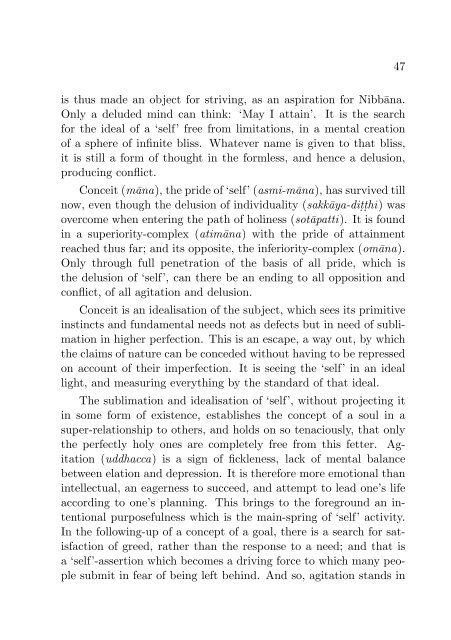Awareness in Buddhist Meditation
A detailed description of awareness in Buddhist Meditation.
A detailed description of awareness in Buddhist Meditation.
Create successful ePaper yourself
Turn your PDF publications into a flip-book with our unique Google optimized e-Paper software.
47<br />
is thus made an object for striv<strong>in</strong>g, as an aspiration for Nibbāna.<br />
Only a deluded m<strong>in</strong>d can th<strong>in</strong>k: ‘May I atta<strong>in</strong>’. It is the search<br />
for the ideal of a ‘self’ free from limitations, <strong>in</strong> a mental creation<br />
of a sphere of <strong>in</strong>f<strong>in</strong>ite bliss. Whatever name is given to that bliss,<br />
it is still a form of thought <strong>in</strong> the formless, and hence a delusion,<br />
produc<strong>in</strong>g conflict.<br />
Conceit (māna), the pride of ‘self’ (asmi-māna), has survived till<br />
now, even though the delusion of <strong>in</strong>dividuality (sakkāya-diṭṭhi) was<br />
overcome when enter<strong>in</strong>g the path of hol<strong>in</strong>ess (sotāpatti). It is found<br />
<strong>in</strong> a superiority-complex (atimāna) with the pride of atta<strong>in</strong>ment<br />
reached thus far; and its opposite, the <strong>in</strong>feriority-complex (omāna).<br />
Only through full penetration of the basis of all pride, which is<br />
the delusion of ‘self’, can there be an end<strong>in</strong>g to all opposition and<br />
conflict, of all agitation and delusion.<br />
Conceit is an idealisation of the subject, which sees its primitive<br />
<strong>in</strong>st<strong>in</strong>cts and fundamental needs not as defects but <strong>in</strong> need of sublimation<br />
<strong>in</strong> higher perfection. This is an escape, a way out, by which<br />
the claims of nature can be conceded without hav<strong>in</strong>g to be repressed<br />
on account of their imperfection. It is see<strong>in</strong>g the ‘self’ <strong>in</strong> an ideal<br />
light, and measur<strong>in</strong>g everyth<strong>in</strong>g by the standard of that ideal.<br />
The sublimation and idealisation of ‘self’, without project<strong>in</strong>g it<br />
<strong>in</strong> some form of existence, establishes the concept of a soul <strong>in</strong> a<br />
super-relationship to others, and holds on so tenaciously, that only<br />
the perfectly holy ones are completely free from this fetter. Agitation<br />
(uddhacca) is a sign of fickleness, lack of mental balance<br />
between elation and depression. It is therefore more emotional than<br />
<strong>in</strong>tellectual, an eagerness to succeed, and attempt to lead one’s life<br />
accord<strong>in</strong>g to one’s plann<strong>in</strong>g. This br<strong>in</strong>gs to the foreground an <strong>in</strong>tentional<br />
purposefulness which is the ma<strong>in</strong>-spr<strong>in</strong>g of ‘self’ activity.<br />
In the follow<strong>in</strong>g-up of a concept of a goal, there is a search for satisfaction<br />
of greed, rather than the response to a need; and that is<br />
a ‘self’-assertion which becomes a driv<strong>in</strong>g force to which many people<br />
submit <strong>in</strong> fear of be<strong>in</strong>g left beh<strong>in</strong>d. And so, agitation stands <strong>in</strong>

















